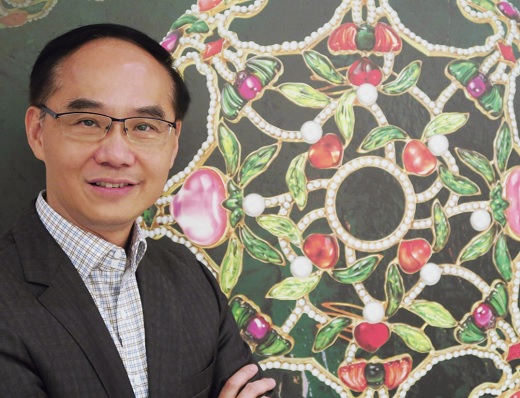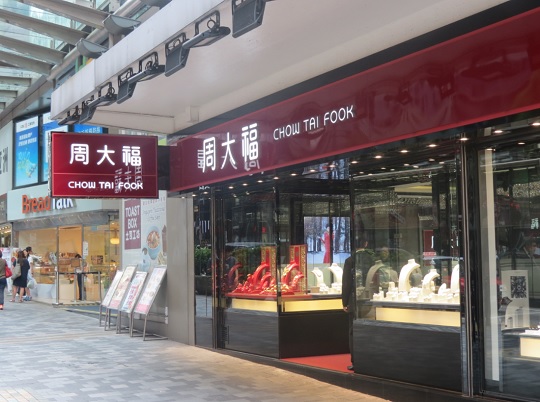|
|
Bringing Personalized Jewelry to the Mass Market
The Five-Minute Interview: Kent Wong
Nov 10, 2016 7:00 AM
By Avi Krawitz
|
|
|

RAPAPORT... Chow Tai Fook continues to endure declining sales as a slowdown in China, especially in Hong Kong, shows little sign of abating. Kent Wong, the company’s managing director (pictured above, courtesy), spoke with Rapaport News outlining its strategy to navigate changing consumer buying patterns and enable long-term growth.
Rapaport News: How has 2016 been for Chow Tai Fook?
Wong: This year has been a challenge. The global economy is still uncertain which has affected buying sentiment. We forecast our sales declines will ease in the fiscal second half since we’re working off a lower base after sales fell last year.
China is now a huge jewelry market. An adjustment was anticipated after a period of such tremendous growth in the previous three-to-five years.
Rapaport News: What is Chow Tai Fook doing to navigate the slowdown?
Wong: The weaker market doesn’t affect our strategy in the medium-to-long term. We believe in China as the economy is still growing at about 6 percent per year.
We continue to implement our “Smart+” strategy, which we launched internally three years ago. It defines how we evaluate and differentiate ourselves to provide the best-quality product and service that will help us achieve our goal to be the most desirable brand in China.
However, we also recognize a need to adapt to a new retail model. We’re looking at how we can personalize our product and service to accommodate evolving consumer buying habits.
Whereas in the past, advertising influenced people, today people influence people. Millennials are highly aware of what their friends are doing. They like to share and show what they have on social media. That is primarily done through mobile, which has emerged as the most important device that connects people to each other as well as to things. That’s done instantly so we have to learn how to capture those instant messages.
Another factor is that the product life cycle is much shorter than before and trends are more difficult to predict. Buying behavior is changing so we have to apapt our selling model.
Rapaport News: How does a large retailer like Chow Tai Fook offer personalization to its customers?
Wong: We initiated a program to capture millennial demand through personalization. We’ve developed a new store concept for a different type of client that offers not just a personalized product but also an experience. At the same time, we continue to strengthen our core business to attract customers through our chain stores and mass production.
Rapaport News: Are we now seeing consolidation in the Chinese and Hong Kong jewelry retail space, reversing the aggressive expansion prior to 2015?
Wong: We have moderated our store expansion program and opened 60 stores (net) last year compared with the 150 to 200 stores that we opened annually previously.
China saw tremendous demand for gold and diamond jewelry in the past decade as people started to accumulate wealth and our strategy was to develop our store network quickly to tap that burgeoning demand.
Today, people are more knowledgeable and have access to more information and the consumer lifestyle has changed. They’re spending differently and are interested in experiences rather than accumulating things.
That’s why travel has become the biggest luxury purchase in China. Tourism increased as people want to try something new and experience different cultures. The second biggest spending is on electronic gadgets and the third is on health care products. So consumption in China is still increasing but it has diversified from 10 years ago.

Rapaport News: Has that affected your inventory requirements?
Wong: Our priority is always to maintain a healthy turnover. We held very large stock two years ago, so we implemented tight inventory controls and refrained from buying rough and polished. Today, our inventory is back to its long-term average level. That means we’re only restocking on the basis of demand.
Rapaport News: Is there less inventory in the pipeline?
Wong: Yes, and I think that trend will continue. Every sector is trying to reduce inventory and, ultimately, improve cash flow. But that’s not the only reason to hold less stock. Consumer behavior is changing so fast. It would be too risky to hold too much stock because the product life cycle has become shorter and the customization trend is so strong.
Rapaport News: Did lower inventory requirements influence your decision to close your diamond cutting factories in Botswana and South Africa?
Wong: It was a strategic decision. We’ve had our polishing center in China since 1989 and that is our major diamond cutting factory today. It makes sense to centralize our operations to realize untapped efficiencies and become more cost effective. Our diamonds go into the cutting center in China, through our jewelry manufacturing unit there and then into the Chinese retail market.
Rapaport News: What motivated your program to sell loose diamonds in the U.S.?
Wong: We’re considering ways of expanding our business not only in China but also by leveraging other expertise, especially in diamonds, design and manufacturing. Our integrated business model is one of our strengths which we feel can drive our expansion into other markets such as the U.S.
Rapaport News: Is that a departure for you as a retailer?
Wong: In fact, at heart we’re a wholesaler since we started out as a loose diamond dealer in Hong Kong. Today, the wholesale business is very small because we expanded our chain-store model. But we have the background, capability and network to be a wholesaler.
We’ve made a long-term commitment to develop the wholesale business in both polished diamonds and jewelry, and set up a new division called ‘Total Jewelry Solution,’ which is responsible for our wholesale division.
It’s not only about providing our clients with high-quality or value-for-money jewelry. We have the capacity to provide more.
For example, we were the first in the jewelry industry to use RFID technology, which enables us to monitor customers’ buying trends and preferences. We can share that experience with retail clients to provide them with a similar capability.
Rapaport News: Do you have plans to expand your retail operations into the U.S.?
Wong: No, we have Hearts on Fire there.
Rapaport News: Can you give us an update on Hearts on Fire?
Wong: We currently have about 140 points-of-sale in China and 19 in Hong Kong as standalone stores, shop-in-shop or counter-in-shop. The customer likes the Hearts on Fire product because it represents the highest standard of diamond cutting. The average selling price of a Hearts on Fire diamond is double that of a generic diamond in Hong Kong and triple the average in China.
The Chinese consumer recognizes Hearts on Fire as an American story. The brand is still run independently by our U.S. team, from marketing to inventory and product development.
Rapaport News: Explain your 4T’s source verification program?
Wong: We’re currently running a pilot program for this project and will have a larger scale advertising campaign and launch in January.
The biggest concern among consumers today is whether their diamond is real. We’ve concluded that our product must be transparent, traceable, thoughtful and truthful. Those are our four T’s.
We’re a vertically integrated company so when rough, or even polished, enters the company pipeline, we can trace it throughout the manufacturing process. Our factories have a very sophisticated system that integrates all the manufacturing stages so we can verify that it’s a natural, real diamond that has been ethically sourced.
We then inscribe the diamond with a hallmark, called the T-Mark, which gives customers confidence the diamond they purchased went through a very clear, transparent and traceable journey.
Rapaport News: Would Chow Tai Fook consider carrying synthetic diamond jewelry?
Wong: No. That would harm our brand because trust is essential in a jewelry brand. If you lose that trust and your commitment to the consumer, you lose the customer.
|
|
|
|
|
|
|
|
|
|
Tags:
Avi Krawitz, Chow Tai Fook, diamonds, Hearts On Fire, Jewelry, Kent Wong, Millennials, Rapaport
|
|
|
|
|
|
|
|
|
|
|

|
|